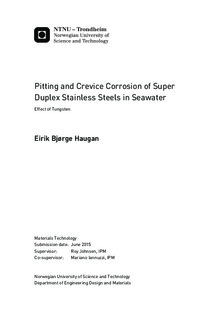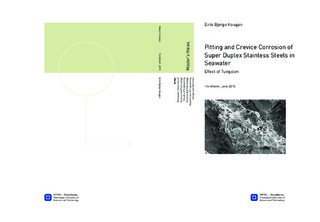| dc.description.abstract | The need for low cost and lighter materials with higher mechanical and chemical properties has lead to more frequently usage of SDSS because of their increased mechanical and superior corrosion properties compared to other stainless steels. SDSS is also relatively less expensive compared to austenitic stainless steels (ASS) due to lower nickel content. This has lead to an increased hunger for knowledge about every aspect of different alloy elements effect on different parameters for the best compromise between price, chemical properties and mechanical properties.
25 wt. % Cr SDSS is frequently used in the oil and gas industry both for seawater applications and for pipes and components exposed to hydrocarbon environments. The composition of SDSS varies depending on the UNS number, primarily in terms of chromium, molybdenum and tungsten contents. During the last years the effect of W on pitting and crevice corrosion resistance has been debated among corrosion experts. In particular, some authors claim that W has a strong synergistic effect with Mo when added above certain threshold value. Tungsten-containing SDSS have been claimed to offer corrosion resistance on a par with higher-grade steels such as type 6Mo (UNS S31254) and 654SMO (UNS S32654) super austenitic grades.
This master´s thesis is a twofold thesis where the main objective in the first part was to investigate the effect of tungsten on crevice corrosion resistance by measuring the critical crevice temperature (CCT) and critical re-passivation temperature after initiation of crevice corrosion (CRTCREV) in short-term conditions (8 hours) by obtaining cyclic potentiodynamic polarization scans (CPDPS) on two SDSS in artificial seawater: a high tungsten chemistry 25 wt. % Cr SDSS and a conventional low-tungsten SDSS, to fully understand tungsten´s effect on localized crevice and pitting corrosion. The second part was obtained in long-term conditions (8 weeks) in natural seawater to simulate actual service conditions to verify the results in part one.
The results of the CPDPD showed that tungsten has a beneficial effect on localized crevice corrosion increasing the CCT and CRTCREV by 10°C, which corresponded with the author´s earlier work and that showed that the critical pitting temperature (CPT) and critical re-passivation temperature after initiation of pitting corrosion (CRTP) increased with 10°C and 30°C. These results were confirmed by the experiments in long-term conditions, which showed increased initiation temperatures when the tungsten content was increased. | |

